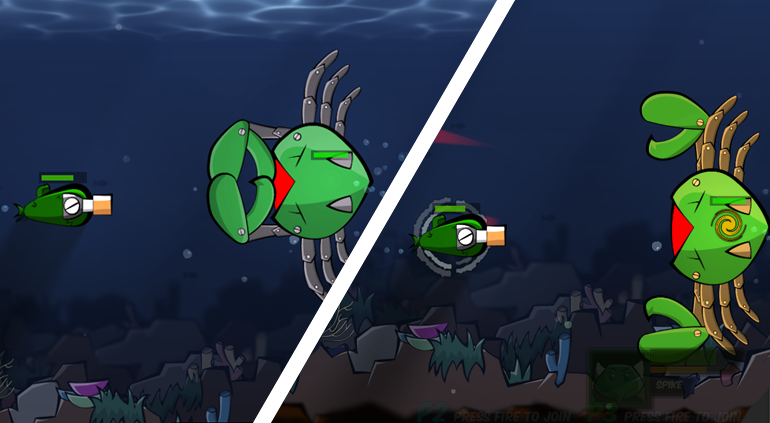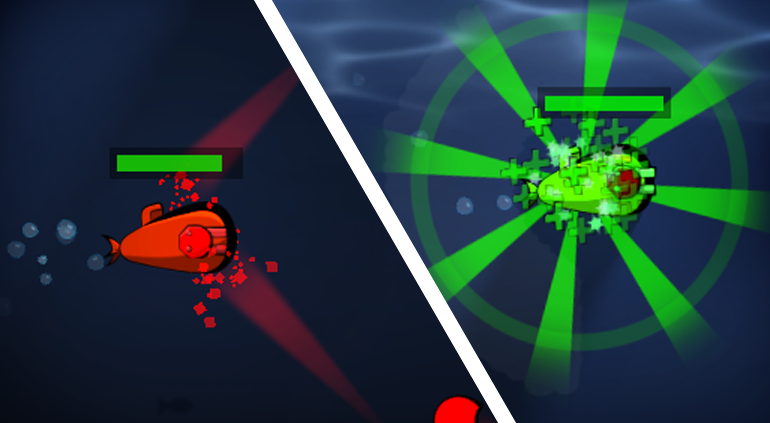-

Rebalance: Promoting Team Play in Fingeance
In the last two weeks, Fingeance has undergone a sweeping set of changes designed to promote teamwork and communication. This rebalance touches everything, but focuses on the pace of combat. From the beginning, we’ve wanted to make our game a Side-Scrolling Shoot-Em-Up with Roles, and a huge part of having “roles” is having them work together in fun and synergistic ways:
- Tank characters should be able to dive in front of allies, saving their lives.
- Leader characters should buff allies or weaken enemies, directing the flow of combat.
- Healer characters should add sustainability or relief to a team, and synergize really really well with tanks.
I feel that, until very recently, we’ve been failing. One batch of playtesters after the next showed us that, with the way our game was, players more or less do their own thing.
Together, but Alone
Here, check out our promo video:
Ask yourself a two questions:
- How often do you see one player save another one?
- How often does one player heal or empower another?
My answers are zero and one time, respectively. 42 seconds in, Dorsa lays down a healing drone, causing Finn to regain a few hit points. There are two problems here:
- Characters don’t interact enough.
- Combat goes so fast that you can’t even tell when they do interact.
Throughout most of the video — supposed to be a showcase of the best moments in our game — players keep mostly to themselves, and almost never get a tangible benefit from working with an ally. This had to change. In 18 months of playtesting, the best moments always came when people had reason to work together. We set out to produce more of those moments.
As it turned out, we produced a lot more.
The Rebalance Changelog
To get an idea of the scope of the changes, take a look at part of the changelog:
- Players no longer heal when picking up scrap.
- Enemy damage reduced by 67%.
A big one. Players take damage much more slowly, but can no longer recover easily. This has three big benefits. First, a tank has much more time to rush to the aid of a dying teammate. Second, healers are far more valuable, since they offer something a team could not get without them. Third, we lose one of the worst moments in the game, which was getting hit by multiple high-damage bullets at once and dying instantly.
- Enemies now reduce the scroll rate while onscreen.
- Larger enemies reduce the scroll rate more.
- On average, medium-sized enemies cut the scroll rate in half.
- This results in fights lasting about 16 seconds, up from 8 seconds.
Huge. Now, players have far more time to understand how enemies work and engage them strategically. Longer combat gives tanks and healers more room to execute their roles, which often require timing and finesse. Not mentioned here is that multiple enemies are gaining “sometimes visible” weak spots, which empowers tanks that can stun enemies and lock them in a vulnerable position.

Crab Battle: The crab is nearly invulnerable while in a defensive position. When it swings its arms open to attack, Spike can stun it, letting the team rack up massive damage.
- Charge-up animation added to all enemy attacks.
Another bonus for characters who can stun or slow enemies, and also for tanks. To state the obvious, seeing when a threat is coming makes it a lot easier to react.
- New Character, [NAME REDACTED], added.
- Left Gadget – Gigarepair – Single target heal.
- Right Gadget – [NAME REDACTED] – [FUNCTION REDACTED].
With the loss of healing, we added an unlockable character with a very simple, direct heal.
- New Gadget for Dorsa.
- Left Gadget – Pickrocket – Piercing projectile. Aim in any direction. Heal self and teammates for each enemy damaged.
We also added a powerful healing toy for Dorsa.
- Health Bars added to players and enemies.
With the addition of stronger healing parts, we thought it was important to make it exceptionally clear which allies are near death.
- Taking damage and healing HP both produce a much stronger visual effect.
Unlike the other changes, this one is purely cosmetic. However, I rate it as one of my favorites, if not my favorite overall. Half the battle, as addressed in the other changes, is giving players the ability to work together. The other half, addressed here, is showing them proof that they are working together, and that it’s awesome. Here we multiplied some visual effects by about 15 (seriously, they were way too faint before) to make it very clear who’s heroically tanking the damage, who’s dishing it out, and who’s healing up.

Hurt and Heal: We’ve increased the visibility of effects that tell you you just got damaged or healed. The same yellow submarine is pictured in both shots.
Slowing Down, Hyping Up
So, if everything is getting slower, does that mean things are less exciting? Not at all. Think of watching an action movie at double speed. Is it more exciting? No way. Gone is the anticipation. Gone is the suspense. The fight scenes are too short, the characters are undeveloped, and everything whizzes by too fast to be understood. In my view, that was Fingeance.
Now that we’re at a slower pace, everyone has time to comprehend the action, invent a strategy, and communicate with teammates. From what we’ve seen so far, this change allows players to work together like never before.
This change also creates memorable moments. Before, the story of a death might have gone like this:
“Things were going okay, but then I lost concentration for a moment and three bullets hit me. I died.”
Now, it’s different. Charles and I had one of our best-ever teamwork moments. We died, but it was still a blast. Here’s the story:
“We were worn down to the bone. We’d just finished a tough level, and were about to fight the boss, One Tough Puffer, with only about 15% of our life remaining. Charles was the new healer, and was trying to slowly patch us up. I, as Spike, was using Shell Block (temporary invulnerability) to shield us from the boss, but it was a nightmare. Every time I stuck my neck out too long and accidentally took a hit, we were one inch closer to death. As soon as I was gone, I knew Charles’ more fragile character would be dead soon too.
“Charles was playing smart. He was using most of his energy to heal me, but was keeping an eye on the boss. Whenever it charged up a big attack (hint! It sucks in air and gets bigger), he lobbed an Ice Grenade (creates a zone of cold, slowing movement and shooting of enemies within. Note: This part now belongs to Dorsa) to slow the boss down, making it wayyyy easier to avoid its attacks.
“It was the turrets that got us. Midway through the fight, red lights and klaxxons flared, signalling one of the boss’s gimmicks: six turrets sprouted from the top and bottom of the screen. We raced to destroy them before they started firing, but we were too slow. Seconds after they began shooting, Charles was torn to shreds (yes, I failed to block a few shots from reaching him). Without a healer, I followed shortly.
“Next time, we should bring an Assault character to help us out.”
Stories like this are exactly what I was hoping for when we first set out to make a “Shoot-Em-Up with Roles.” Longer, tenser fights make the stories — and the teamwork — so much better.
-
